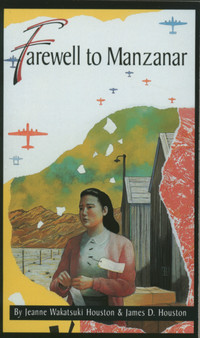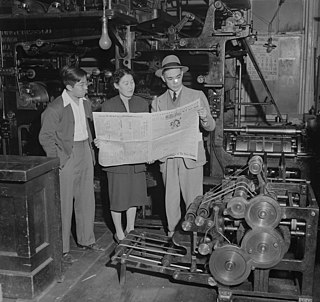
Manzanar is the site of one of ten American concentration camps, where more than 120,000 Japanese Americans were incarcerated during World War II from March 1942 to November 1945. Although it had over 10,000 inmates at its peak, it was one of the smaller internment camps. It is located at the foot of the Sierra Nevada mountains in California's Owens Valley, between the towns of Lone Pine to the south and Independence to the north, approximately 230 miles (370 km) north of Los Angeles. Manzanar means "apple orchard" in Spanish. The Manzanar National Historic Site, which preserves and interprets the legacy of Japanese American incarceration in the United States, was identified by the United States National Park Service as the best-preserved of the ten former camp sites.

Farewell to Manzanar is a memoir published in 1973 by Jeanne Wakatsuki Houston and James D. Houston. The book describes the experiences of Jeanne Wakatsuki and her family before, during, and following their relocation to the Manzanar internment camp due to the United States government's internment of Japanese Americans during World War II. It was adapted into a made-for-TV movie in 1976 starring Yuki Shimoda, Nobu McCarthy, James Saito, Pat Morita, and Mako.

Little Tokyo, also known as Little Tokyo Historic District, is an ethnically Japanese American district in downtown Los Angeles and the heart of the largest Japanese-American population in North America. It is the largest and most populous of only three official Japantowns in the United States, all of which are in California. Founded around the beginning of the 20th century, the area, sometimes called Lil' Tokyo, J-Town, Shō-Tōkyō (小東京), is the cultural center for Japanese Americans in Southern California. It was declared a National Historic Landmark District in 1995.

The Verdugo Mountains, also known as the Verdugo Hills or simply The Verdugos, are a small, rugged mountain range of the Transverse Ranges system in Los Angeles County, California. Located just south of the western San Gabriel Mountains, the Verdugo Mountains region incorporates the cities of Burbank, Glendale, Pasadena, and La Cañada Flintridge; the unincorporated communities of Altadena and La Crescenta-Montrose; as well as the City of Los Angeles neighborhood of Sunland-Tujunga. It is where the borders of the San Gabriel Valley and the San Fernando Valley meet.

The Fairplex has been the home of the L.A. County Fair since 1922. Known prior to 1984 as the Los Angeles County Fairgrounds, it is located in the city of Pomona, California. The L.A. County Fair is held during the month of May since 2022, but the facility is used year-round to host a variety of educational, commercial, and entertainment such as trade and consumer shows, conventions, and sporting events.

The Rafu Shimpo is a Japanese-English language newspaper based in Little Tokyo, Los Angeles, California and is the largest bilingual English-Japanese daily newspaper in the United States. As of February 2021, it is published online daily. In print publication is only on Tuesday, Wednesday, Thursday, and Saturday.

Tujunga Wash is a 13-mile-long (20.9 km) stream in Los Angeles County, California. It is a tributary of the Los Angeles River, providing about a fifth of its flow, and drains about 225 square miles (580 km2). It is called a wash because it is usually dry, especially the lower reaches, only carrying significant flows during and after storms, which usually only occur between November and April. The name of the wash derives from a Tongva village name.

California's 29th congressional district is a congressional district in the U.S. state of California based in the north central San Fernando Valley. The district is represented by Democrat Luz Rivas.
Dan Kwong is an American performance artist, writer, teacher and visual artist. He has been presenting his solo performances since 1989, often drawing upon his own life experiences to explore personal, historical, and social issues.

Bolton Hall is a historic American Craftsman-era stone building in Tujunga, Los Angeles, California. Built in 1913, Bolton Hall was originally used as a community center for the utopian community of Los Terrenitos. From 1920 until 1957, it was used as an American Legion hall, the San Fernando Valley's second public library, Tujunga City Hall, and a jail. In 1957, the building was closed. For more than 20 years, Bolton Hall remained vacant and was the subject of debates over demolition and restoration. Since 1980, the building has been operated by the Little Landers Historical Society as a local history museum.
Togo "Walter" Tanaka was an American newspaper journalist and editor who reported on the difficult conditions in the Manzanar camp, where he was one of 110,000 Japanese Americans who had been relocated after the Japanese attack on Pearl Harbor on December 7, 1941.

Sunland-Tujunga is a Los Angeles city neighborhood within the Crescenta Valley and Verdugo Mountains. Sunland and Tujunga began as separate settlements and today are linked through a single police station, branch library, neighborhood council, chamber of commerce, city council district, and high school. The merging of these communities under a hyphenated name goes back as far as 1928. Sunland-Tujunga contains the highest point of the city, Mount Lukens.
Wintersburg Village is an area in Huntington Beach, California, United States, that represents over a century of Japanese immigration to the United States. The property, consisting of six structures on a 4.5-acre (1.8 ha) parcel, was noted as eligible for the National Register of Historic Places in the City of Huntington Beach General Plan in 2014. The C.M. Furuta Gold Fish Farm and the Wintersburg Japanese Mission are recognized nationally by historians as a rare, pre-1913 Japanese pioneer-owned property with intact physical features that convey the progression of Japanese American history.
Sei Fujii was a human rights activist for Japanese-American individuals. He also established a California daily newspaper in 1931.

The Temporary Detention Camp for Japanese Americans / Pomona Assembly Center is one of the places Japanese Americans were held during World War II. The Pomona Assembly Center was designated a California Historic Landmark on May 13, 1980. The Pomona Assembly Center is located in what is now called the Fairplex in Pomona, California in Los Angeles County. The Pomona Assembly Center was called Los Angeles County Fairgrounds in 1942.

Yuki Helen Okinaga Hayakawa Llewellyn was an American child survivor of the Japanese internment process during World War II. A 1942 photograph of her sitting on her mother's luggage became an iconic image of the era. In adulthood, Llewellyn was assistant dean of students at the University of Illinois, and frequently spoke on her childhood experience of displacement and incarceration.

Takayo "Rose" Matsui Ochi was a Japanese-American attorney and civil rights activist notable for fighting for the approval of the Manzanar to become a National Historic Site and being the first Asian American woman to be appointed at the United States Assistant Attorney General level by President Bill Clinton. She was also the first Asian American to be appointed to the Los Angeles Police Commission.
Grace Aiko Nakamura was a Japanese American educator and the first Japanese American teacher to be hired in the Pasadena Unified School District.













